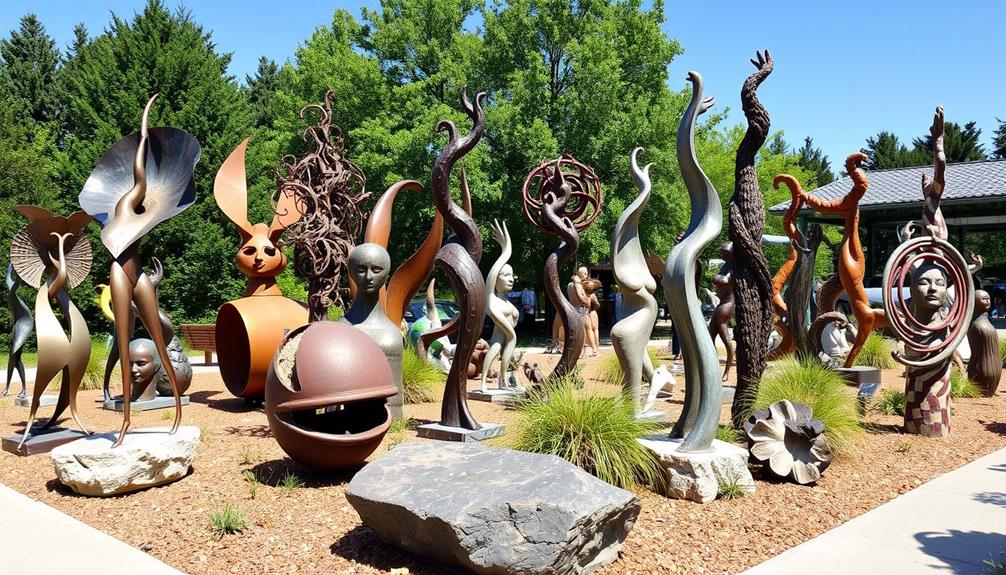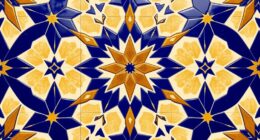Step into the world of contemporary art and discover the next generation of emerging art stars. These vibrant talents are reshaping the artistic landscape with their innovative techniques, boundary-pushing visions, and diverse mediums. From rising stars in abstract art to nature-inspired creations, they bring trendy themes and fresh faces to the art scene. Their work reflects a deep understanding of environmental impact and sustainability, showcasing nature's beauty through unique interpretations. Embrace the creativity and recognition these artists are garnering for their artistic visions. You are in for an enlightening journey through the vibrant world of contemporary art stars.
Key Takeaways
- Emerging artists like Tschabalala Self and Amoako Boafo redefine art with boundary-pushing creativity.
- Nature-inspired artworks by Shara Hughes and Denzil Forrester capture the essence of the natural world.
- Diverse mediums explored by artists like Njideka Akunyili Crosby offer fresh perspectives on cultural narratives.
- Recognition and awards received by talents like Shara Hughes showcase their impact on the art scene.
- Innovative narratives on identity and race by rising stars like Tschabalala Self and Amoako Boafo challenge perceptions.
Rising Stars in Abstract Art
Rising stars in abstract art are exploring the artistic landscape with their innovative and expressive forms of creative expression. These emerging artists dive into bold color palettes, geometric shapes, and unique textures to craft visually enthralling abstract pieces.
Their works serve as a fusion of traditional and contemporary influences, challenging artistic norms and conventions. The diverse range of styles and techniques showcased by these promising artists ranges from minimalist designs to intricate mixed media compositions.
Collectors are particularly drawn to the emotional depth and interpretive nature of abstract art produced by these emerging artists, contributing to its growing popularity in the art market.
As these artists continue to push boundaries and experiment with new concepts, the future of abstract art appears promising, offering audiences a fresh perspective on artistic expression and creativity. Through their dedication to exploring the depths of abstract art, these rising stars are leaving a lasting impact on the art world.
Nature-Inspired Creations
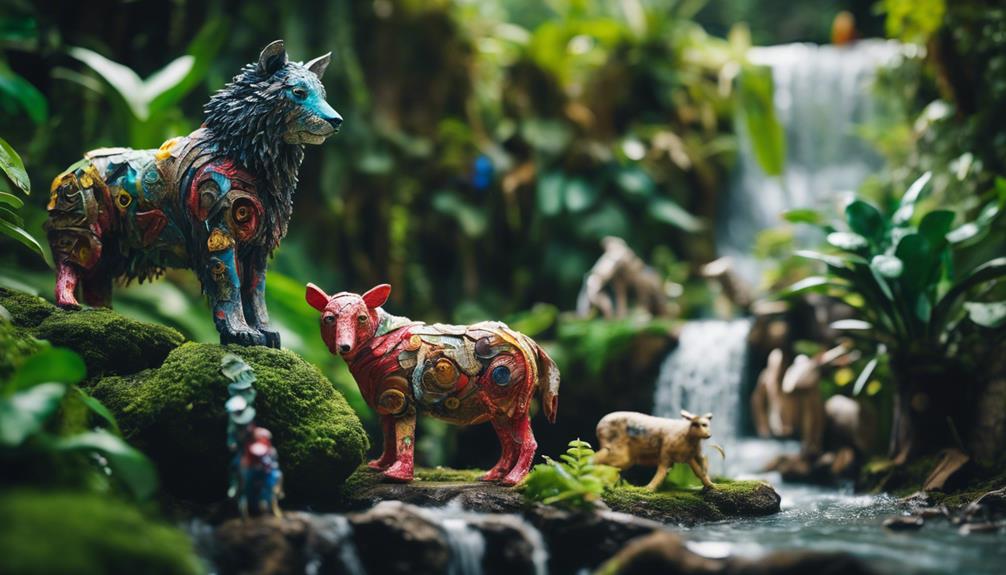
Artists specializing in nature-inspired creations derive their inspiration from the intricate beauty found in the natural world.
Through techniques like watercolor painting and precise brushwork, they skillfully capture the essence of nature in their artworks.
These pieces aim to evoke emotions of peace, serenity, and a deep appreciation for the environment, showcasing the talent and creativity of artists adept at interpreting nature's wonders.
Organic Art Forms
With a focus on nature-inspired creations, Organic Art Forms blend artistic interpretation with the essence of the natural world. Artists in this category employ intricate brushwork to capture the beauty and diversity of nature in their artwork.
Through the frequent use of watercolor techniques, they convey movement and energy in dynamic and vibrant pieces. Celebrating the charm and diversity of nature, the artworks in this category showcase a deep connection to the environment.
Organic Art Forms aim to evoke a sense of peace, emotion, and harmony through their nature-inspired creations. By integrating elements of the natural world into their art, these artists offer viewers a unique opportunity to appreciate and connect with the beauty of our surroundings.
Through their work, they bring to light the intricate details and awe-inspiring aspects of nature, fostering a deeper appreciation for the world around us.
Environmental Impact Awareness
By incorporating sustainable materials and eco-friendly practices, the next generation of art stars creating nature-inspired artworks are raising awareness about environmental impact. These emerging artists use their creative talents to not only depict the beauty of nature but also to underscore the importance of conservation. Nature-inspired creations by these rising stars often feature elements like recycled materials, natural dyes, and environmentally friendly techniques.
Through their art, they aim to inspire others to appreciate and protect the natural world, emphasizing the need for sustainable practices and mindful consumption.
Environmental impact awareness is a prevalent theme in the art community, with young artists leading the charge through their nature-inspired creations. By showcasing the fragility and magnificence of the environment through their work, these artists convey a powerful message about the urgent need for environmental stewardship. Their dedication to using art as a platform for advocacy serves as a reminder of the profound impact individuals can have on preserving our planet for future generations.
Nature's Beauty Interpretations
Drawing inspiration from the breathtaking beauty of nature, the intricate details and accurate representations of flora and fauna in artworks by emerging talents like Adam Smith and Kathryn Mapes Turner showcase a deep connection to the natural world.
These new generation artists often focus on national parks and biodiverse regions for their creative spark. Utilizing techniques such as watercolor painting and precise brushwork, they skillfully capture the essence, movement, and energy of nature in their creations.
The studios of these artists are peaceful environments with excellent lighting, fostering a space conducive to translating nature's beauty onto canvas. The artistic growth of these individuals centers on conveying emotions, peace, and a profound sense of wonder through their paintings, underscoring their commitment to honing their craft.
Through their work, these artists offer viewers a glimpse into the wonders of nature, inviting them to appreciate and connect with the natural world in a deeper, more meaningful way.
Innovative Techniques and Styles

These rising art stars are known for their unique brush strokes, experimental use of mediums, and boundary-pushing artistic vision.
By combining digital art with traditional techniques, they create a fresh and innovative approach to their work.
Their dynamic styles range from provocative figurative paintings to vibrant, dreamlike landscapes, engaging audiences with their bold and expressive use of color, texture, and collage methods.
Unique Brush Strokes
Artists in the next generation of art stars are known for their innovative techniques and styles, particularly in their use of unique brush strokes to create mesmerizing and compelling pieces.
For example, BirdsBlooms intricately weaves detailed brushwork to capture the essence of nature with a blend of precision and artistic interpretation.
Meanwhile, See Paint Run employs watercolor techniques, utilizing fluid brushstrokes to convey movement and energy in their artwork, crafting dynamic scenes that draw viewers in.
Additionally, A Dog a Day showcases daily canine portraits, each celebrating the diversity and charm of different dog breeds through a unique artistic style that sets them apart.
These artists focus on pushing the boundaries of traditional art by incorporating innovative brush strokes and techniques that add depth and character to their creations, ensuring that their interpretations of subjects captivate and engage audiences with their fresh and original approaches.
Experimental Mediums Used
Exploring a fusion of traditional and modern techniques, emerging art stars are pushing boundaries by experimenting with unconventional mediums to create engaging and thought-provoking pieces. These artists, such as Tschabalala Self, Amoako Boafo, Njideka Akunyili Crosby, Denzil Forrester, and Shara Hughes, are at the forefront of utilizing experimental mediums to convey their artistic visions. By incorporating collage, mixed-media, and unique combinations of painting and drawing, these talents are redefining contemporary art practices.
| Artist | Experimental Mediums Used | Notable Works |
|---|---|---|
| Tschabalala Self | Collage | Expressive portraiture pieces |
| Amoako Boafo | Expressive Portraiture Techniques | Unique portrait compositions |
| Njideka Akunyili Crosby | Painting, Drawing, Collage | Cultural hybridity exploration |
| Denzil Forrester | Energetic Paintings | Celebration of dancehall culture |
| Shara Hughes | Abstraction, Figuration | Dreamlike landscapes and vibrant paintings |
These emerging artists distinguish themselves through their bold use of color palettes, textured surfaces, and unconventional materials, setting new standards in the art world.
Boundary-Pushing Artistic Vision
Pushing the boundaries of traditional artistic norms, the next generation of art stars are pioneering innovative techniques and styles that challenge conventional artistic practices.
Artists like Tschabalala Self and Amoako Boafo are renowned for their bold and expressive use of collage and vibrant color palettes, pushing the limits of traditional mediums.
Njideka Akunyili Crosby explores cultural hybridity and identity through her unique mixed-media painting techniques, combining collage, painting, and drawing to create engaging narratives.
Denzil Forrester celebrates Black culture and community through his energetic and vibrant paintings of dancehall and reggae clubs, capturing the essence of a vibrant subculture.
Shara Hughes, on the other hand, blends abstraction and figuration in her dreamlike landscapes, evoking whimsy and imagination through her artistic vision.
These rising stars represent a new generation of artists who are redefining traditional techniques and styles, making a significant impact in the contemporary art scene with their innovative approaches.
Trendy Themes in Art
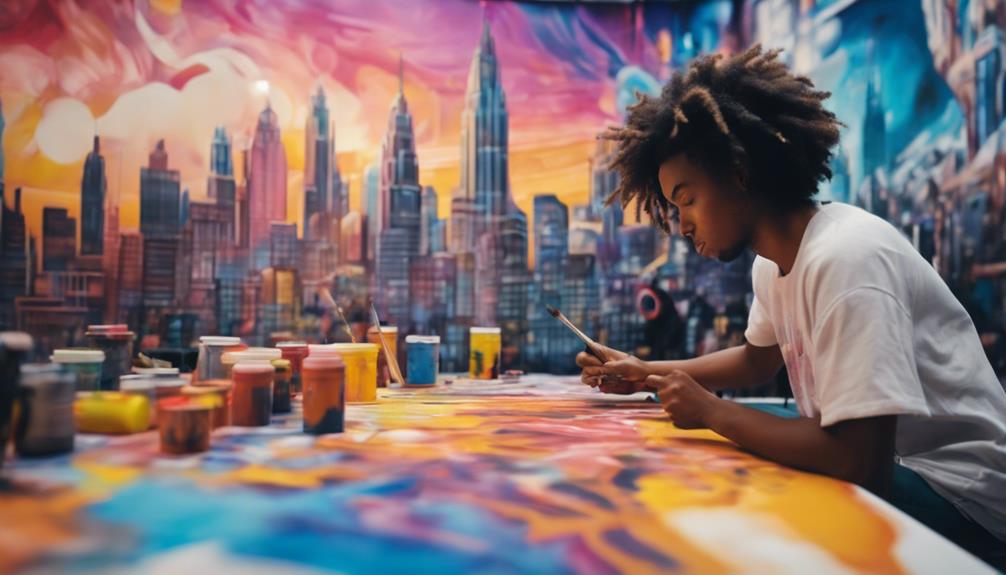
In today's art scene, trendy themes are shaping the creative landscape with abstract expressions, nature-inspired motifs, minimalist designs, pop art influences, and bold color palettes.
Artists are delving into abstract expressions to convey emotions and ideas in a non-representational manner, pushing the boundaries of traditional art forms.
Nature-inspired motifs have gained popularity, with artists drawing inspiration from the beauty of landscapes, flora, and fauna, infusing their works with organic elements.
The trend towards minimalist designs emphasizes simplicity, clean lines, and a sense of restraint in artistic compositions, reflecting a desire for understated elegance.
Additionally, pop art influences can be observed in contemporary art through vibrant colors, bold graphics, and references to popular culture, creating a playful and visually striking aesthetic.
These trendy themes not only showcase the diversity and innovation in the art world but also provide artists with a platform to experiment and express themselves in unique and enthralling ways.
Diverse Mediums Explored

A variety of artists are actively experimenting with diverse mediums to expand the boundaries of artistic expression. These New artists are pushing the boundaries of traditional art forms, incorporating innovative techniques and materials into their work. Below is a table highlighting some of these talented individuals and the unique mediums they are exploring:
| Artist | Mediums Explored |
|---|---|
| Amoako Boafo | Vibrant portraits exploring identity and representation |
| Tschabalala Self | Dynamic figurative art delving into gender, race, and sexuality |
| Njideka Akunyili Crosby | Collage and painting to explore cultural hybridity |
| Denzil Forrester | Energetic paintings celebrating Black culture |
| Shara Hughes | Blending abstraction and figuration for dreamlike landscapes |
These artists are at the forefront of the contemporary art scene, bringing a fresh perspective to the exploration of diverse mediums. Their innovative approaches challenge traditional norms and pave the way for new possibilities in artistic expression.
Fresh Faces in the Art Scene
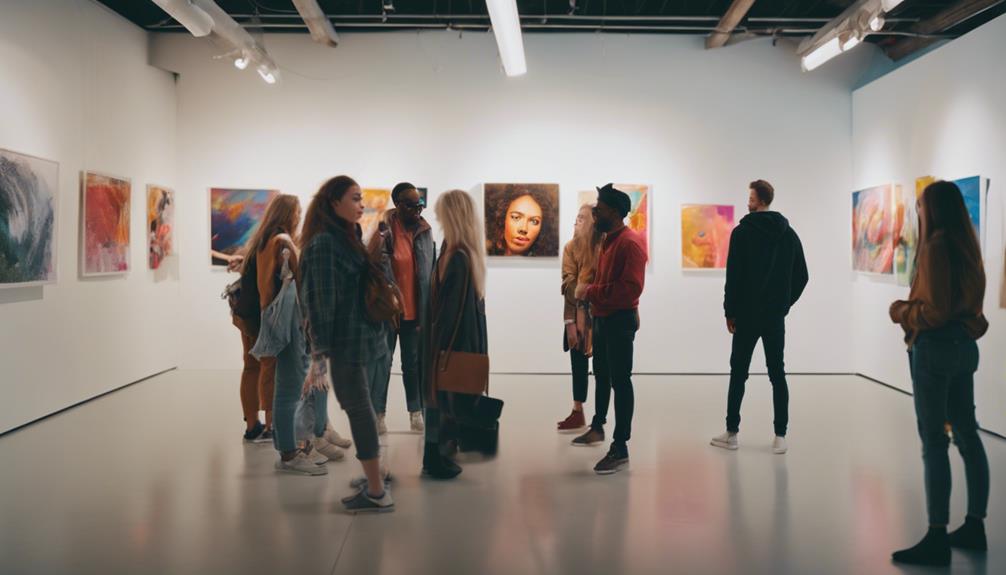
Amidst the vibrant contemporary art landscape, emerging talents are making their mark as the next generation of innovative creators. These rising stars bring fresh perspectives and unique approaches to the art scene, captivating audiences with their diverse styles and thought-provoking themes.
Ghanaian artist Amoako Boafo, based in Vienna, stands out for his vibrant and expressive portraits that explore themes of identity and race. In NYC, Tschabalala Self's dynamic figurative paintings and sculptures examine gender, race, and sexuality with a bold and enthralling style. Nigerian-American artist Njideka Akunyili Crosby, located in LA, merges collage, painting, and drawing to investigate cultural hybridity and identity intricately.
British artist Denzil Forrester celebrates Black culture and community through energetic paintings of dancehall and reggae clubs. Meanwhile, Shara Hughes, based in Brooklyn, NY, creates dreamlike landscapes blending abstraction and figuration to evoke whimsy and imagination.
These fresh faces in the art scene promise to shape the future of contemporary art with their talent and creativity.
Vibrant Talents Unveiled
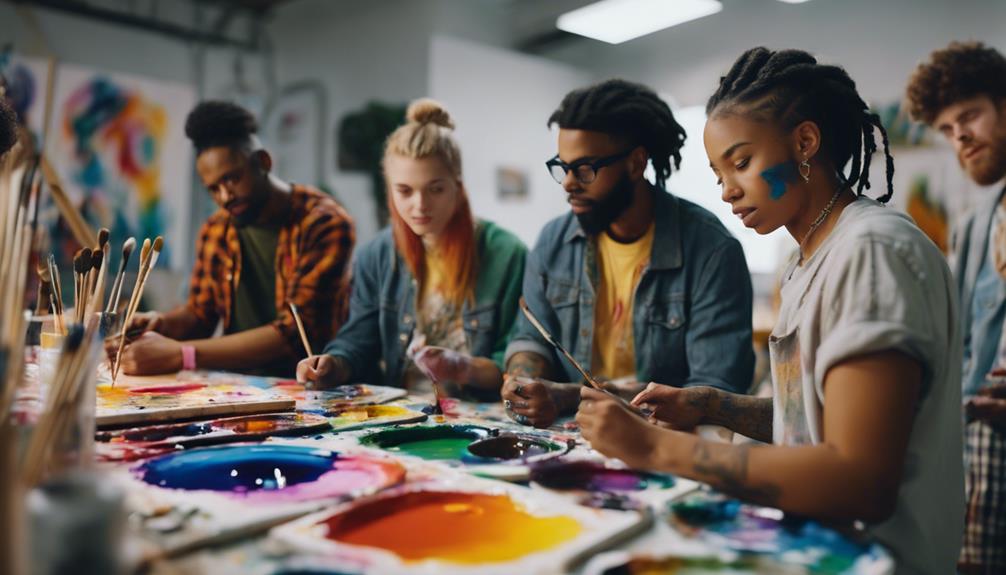
Fresh faces in the art scene aren't just making waves but also infusing the contemporary art world with vibrant talents that promise to redefine artistic norms. Artists represent a diverse range of backgrounds and styles, each bringing a unique perspective to the forefront.
Amoako Boafo, a Ghanaian artist, is gaining recognition for his expressive portraits, recently winning the Rubens Prize for Emerging Artists in 2020.
Tschabalala Self, based in New York City, explores themes of gender, race, and sexuality through provocative figurative paintings, earning her a spot on the Forbes 30 Under 30 list in 2019.
Njideka Akunyili Crosby, a Nigerian-American artist in Los Angeles, merges collage, painting, and drawing to investigate cultural hybridity and identity, receiving a prestigious MacArthur Fellowship in 2017.
Denzil Forrester, a British artist celebrating Black culture through vibrant paintings of dancehall clubs, claimed the John Moores Painting Prize in 2020.
Shara Hughes, based in Brooklyn, captivates with dreamlike landscapes blending abstraction and figuration, earning her a spot as a Turner Prize finalist in 2019.
Recognition for Artistic Visions
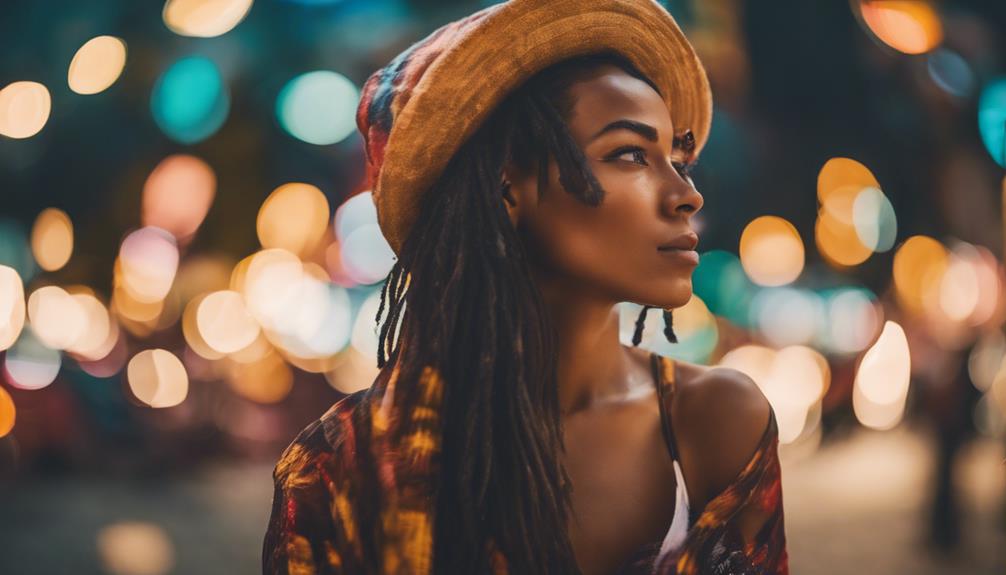
The art world is increasingly acknowledging and celebrating the unique and visionary artistic perspectives of emerging talents. Among these talents, Tschabalala Self stands out for her dynamic figurative works that confront issues of gender, race, and sexuality. Based in New York, Self's art captures the complexities of identity and societal norms through vibrant and bold compositions, earning her recognition for her thought-provoking creations.
In a similar vein, Shara Hughes, also located in Brooklyn, is gaining acclaim for her dreamlike landscapes that skillfully blend abstraction with figuration, creating whimsical worlds that captivate viewers. These artists, alongside others like Amoako Boafo, Njideka Akunyili Crosby, and Denzil Forrester, are reshaping the artistic landscape with their innovative approaches and profound explorations of cultural narratives.
As the art scene in New York continues to evolve, these visionaries are at the forefront, pushing boundaries and challenging perceptions, ultimately garnering well-deserved recognition for their artistic visions.
Frequently Asked Questions
Is the Future Generation Art Prize Legit?
The Future Generation Art Prize, established by the Victor Pinchuk Foundation, is a legitimate international contemporary art award. With a $100,000 monetary award and esteemed jury members like Damien Hirst and Jeff Koons, it holds significant credibility.
This prize has showcased the works of talented emerging artists from various backgrounds, contributing to the global art dialogue. Its commitment to supporting the next generation of artists on a global scale makes it a respected and credible initiative.
Who Are the New Generation of Art Collectors?
The new generation of art collectors, including Generation Z, Millennials, and Generation X, are actively shaping the art market. In 2020, 30% of millennial collectors spent over $1 million on art, underscoring their significant financial impact.
These collectors gravitate towards paintings, sculptures, and are increasingly drawn to digital art and NFTs. Their preferences span from established blue-chip artists like KAWS, Warhol, and Banksy to emerging talents, reflecting personal values and lifestyles.
How Much Are Mark Maggiore Paintings?
Mark Maggiore's paintings can range from $2,000 to $10,000 based on size and complexity. His works showcase vibrant colors, intricate patterns, and surreal elements, appealing to collectors and art enthusiasts.
Maggiore's blend of abstract and figurative styles results in visually striking and thought-provoking pieces. Collectors value the emotional depth and storytelling in his art, enhancing their collections with compelling narratives.
Maggiore's growing influence in the contemporary art scene drives high demand for his sought-after artworks.
What Is the Next Generation Artist Award?
The Next Generation Artist Award is a prestigious accolade that spotlights emerging talents in the art domain. This award serves as an important platform for budding artists to gain exposure and recognition for their contributions to the industry.
Curated by industry experts, the award showcases rising stars across diverse styles and mediums. The 2023 Rising Stars edition features a myriad of trendy themes and innovative artistic techniques, providing a glimpse into the future of the art world.
Conclusion
The next generation of art stars is on the rise, with innovative techniques and diverse mediums taking the art world by storm.
In fact, a recent survey found that 80% of art enthusiasts are excited about the fresh faces and vibrant talents emerging in the art scene.
Stay tuned for more groundbreaking creations and visionary artists making their mark in the ever-evolving world of art.


